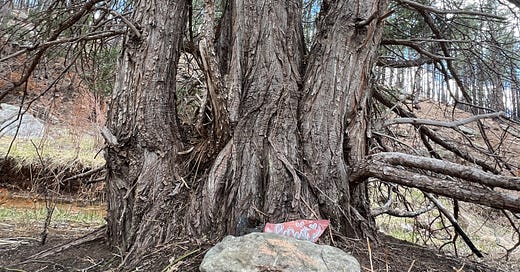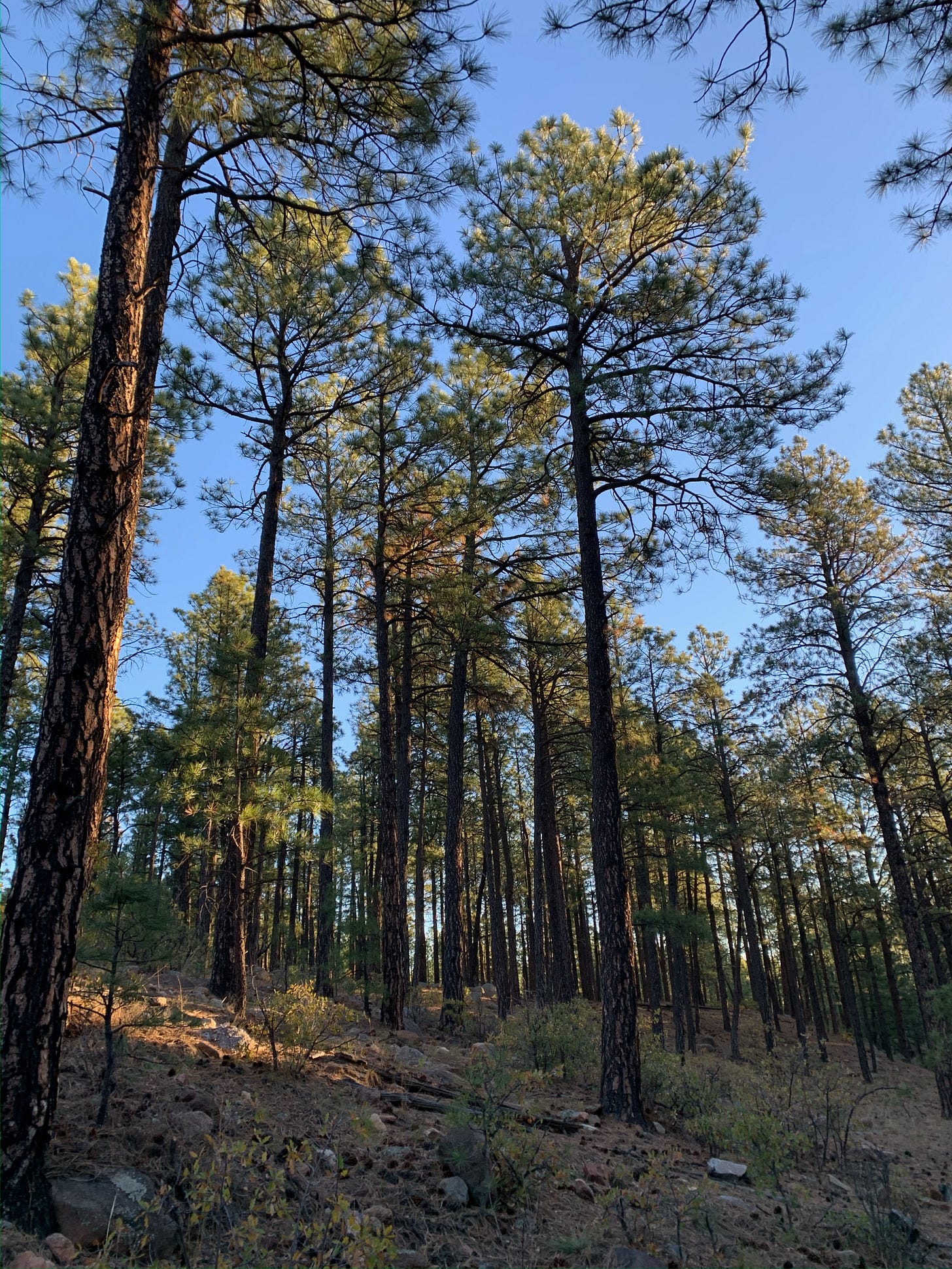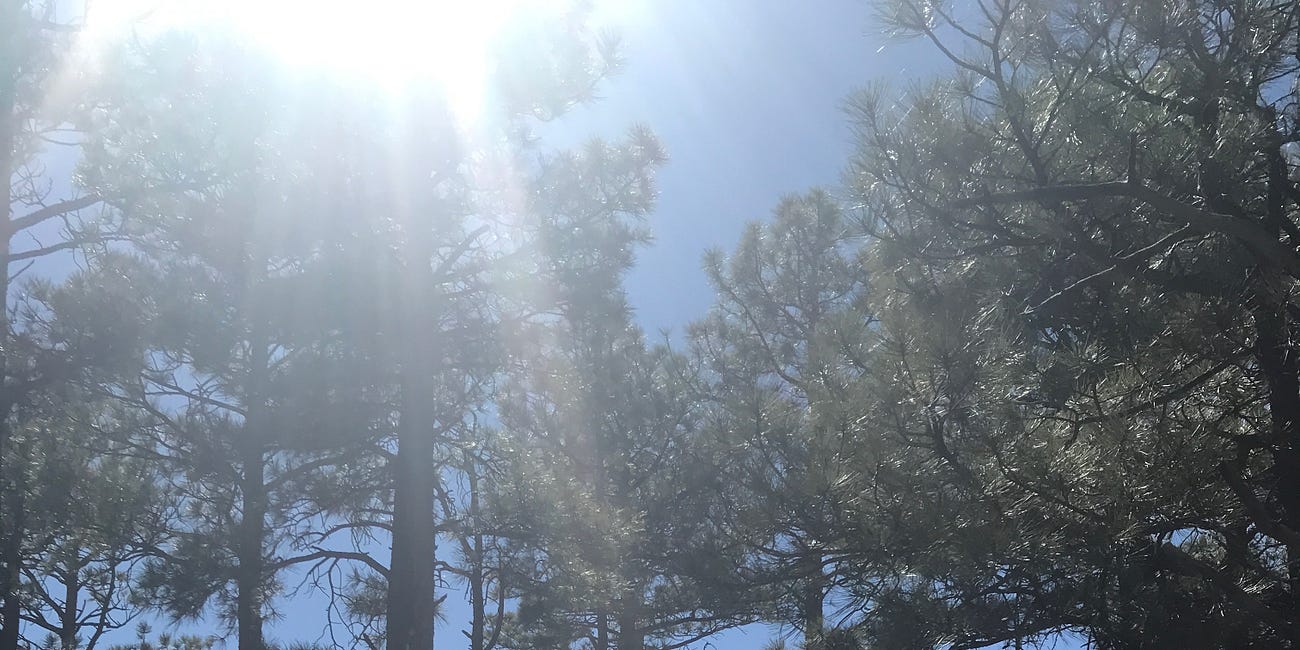Courtship is a slow dance, a gradual getting to know each other with conversation and gifts. Inherent in courtship is respect, patience, and gently growing emotional intimacy with the beloved.
The opposite of courtship is entitled ownership. “I want you, therefore I will and can have you. I will overrun your needs and wants and even your consent to take what I believe is already mine.”
We have a funny kind of entitled ownership in relationship with land: “I bought this, my name is on the deed, therefore it is my private place, to fence off and claim.” The entitlement comes in when we believe the land is empty, devoid of life, agency, and wisdom. We get to decide what we want to put on it, without considering what the other wants.
The United States is built on this type of entitlement, which was called manifest destiny. Manifest destiny was a phrase in the 19th-century United States that represented the belief that American settlers were destined to expand westward across North America, and that this belief was both obvious ("manifest") and certain ("destiny").
“I want this land that I just 'discovered' therefore it is now mine. I will do what I want with it and ignore the rights and inherent worth of other humans, trees, animals, and earth.”
I never thought I would own land, or a house, in this lifetime. I was content to travel and rent and visit my stable, rooted friends. I did dream of having a retreat center, of creating sacred space. But I never wanted to “own” land, or tie myself down to one place.
When I bought the land here in Northern New Mexico I made two vows: That I would learn how to steward it with love and appreciation, and that I would never create a burden that the land had to earn money. I wanted the land to be whole unto itself, a place to discover and rest into rather than a place dominated by will, or demanded pay for itself in some way.
So each step of building here, from the community kitchen to the yurt to the bathhouse has been slow, sometimes spontaneous, sometimes thought out, and pieced together like a marvelous jigsaw puzzle. Love in progress.
I'm sitting in the community kitchen right now writing this article, and while we have an incredibly beautiful wood ceiling with grand beams, huge windows including an eight foot sliding glass door and a large Amish propane fridge I drove to Arizona to pick up, under my feet is gravel, covered by old rugs.
The four-part sink and propane stovetops are from our original outdoor kitchen. The shelving is grey plastic that we bought from a second-hand store. The doors and window trim still needs to be added, and there is insulation stuffed around the top beams. We are using milk crates, an old camping table that came with my tent, and a gifted wooden crate cabinet to store food, pots and pans, and supplies. Coffee and tea, grains and pasta are stored in clear plastic bins.
Sometimes I wish I had unlimited funding to craft the vision: finish the kitchen with custom cabinets, lay brick on the floors, buy beautiful countertops, add the second story apartment, build cabins, landscape. And I constantly remind myself: slow allows more listening. Slow lets us be in the space and feel what is needed next. Slow allows more hands and hearts to come together in community for work parties and fundraisers.
And, of course, I have also had to slow down to tend to the land and my heartbreak post-wildfire.
Okay then, back to courtship as stewardship, and stewardship as courtship.
In Part 1 of this series, Talking to Trees, I shared how I sensed the land was polite but distant towards me, and when I asked how I could be closer I receive the message: “Honor the trees.” (Read Talking to Trees here)
I was a little puzzled by this message, so I walked down to what I called our Mama Tree.
Mama Tree is an enormous ponderosa pine down by the creek. Most of our ponderosa pines are about 50 years old, which is when the last wildfire came through these lands. This pine is probably closer to 150 years old, its one large trunk branching about eight feet up into two mirrored trunks that stretch about 100 feet into the sky.
It was on the north side of Mama Tree that I build our first altar on the land. It started out as a few consciously placed pine cones and branches, and over the years grew to include a heavy gold obsidian Guadalupe statue I carried back from Mexico, an antelope skull with fuzz still on the antlers, a meteorite star from Peru, a one-gallon-sized quartz crystal, a cracked bowling ball found in the garbage pile up the hill, and various malas, rosaries, rocks, and beads.
As I walked up to Mama Tree I touched her bark, then sat down to have a chat.
“Hi, sweetheart.” I said out loud.
Then I closed my eyes, and listened.
In about two minutes information streamed straight into my heart, I knew what I needed to do.
While I had asked the land for permission to be there, done countless offerings, and wandered about talking to the trees, I was being invited to more formally connect with the different types of trees on the land. I needed to introduce myself properly and share gifts and prayers to each species, so they could share with their brethren. I was being invited into a courtship with the land, through the trees.
I opened my eyes and said, “I understand. Thank you.”
I poured water on the altar and on the trunk of the Mama Tree, thanking her for her gift of shade and beauty and strength. I praised her dark roots and her green tassels. I asked her to bring a message to all of the other ponderosa pines that I was here in love, to listen and support this land and the trees.
There was a shift in my body, a acknowledgment and then a tug to find the next tree.
I walked east down the creek, and laughed out loud when I saw the next tree: a gigantic, flame-shaped juniper. This was the oldest juniper I'd seen on the property, with its pale brown, stripey, papery bark and bumpy, curvy base.
“This is the fire tree,” I thought. “The Mama Tree is the earth tree. That means there are water trees and air trees for me to find as well.”
It took me a bit of searching to find the water tree, which ended up being behind me: a cottonwood growing in a sandy hill a couple of hands-width from the water. The air tree was also tricky, but soon I found a small circular grove of oak trees, up the hill from the creek, closer to the dirt road.
“Okay, I'll be right back,” I said to each of the trees.
I gathered supplies: flat stones for the altars, items for each of the elements of air, fire, water, and earth. More water for the trees. Corn meal and crushed lavender. A ceramic rattle for fire. Some blue glass for water. An empty bottle for air. A piece of quartz from the land for earth. Candles.
Over the next hour I introduced myself to each tree group: pine, juniper, cottonwood, oak. I asked them to let their friends know I was here to listen and tend. I build altars for each tree. I poured water, sprinkled offerings, prayed. I cried. I laid down on the earth and gazed into their branches. I rested my back against bark. I noticed how different each tree was. I smelled needles and stroked leaves. I said over and over, “I apologize that I haven't been by sooner to say hello.” I slowed down to let myself feel and to invite the trees to feel me as well.
When the ceremony felt complete I walked back up to the house. As I spread my awareness and touched the land, I sensed a peace, a welcoming, and an acknowledgment.
“I see you,” I said out loud to the forest.
“We see you,” the trees responded.
And the courtship began.
Part 1:
Talking to Trees
In April 2020 I signed the final paperwork to become sole owner of two adjoining pieces of property in the wilds of New Mexico. The land was so remote it took a entire paragraph to describe its location: Tract I: Lot 10 B containing 19.98 acres, more or less, lying within Government Lot 10, being a portion of Small Holding Claim No. 6020 Tract 1, within S…








So simple and beautiful HeatherAsh❤️🌲🌳Thank you for this story of how simple and easy it is to communicate with the plant beings we share our world with.
Just beautiful. When I stated my first herbalism course, it began with a ‘courtship of seeds’ and forever changed my perspective. Thank you for this beautiful share 🩵🌿🙏